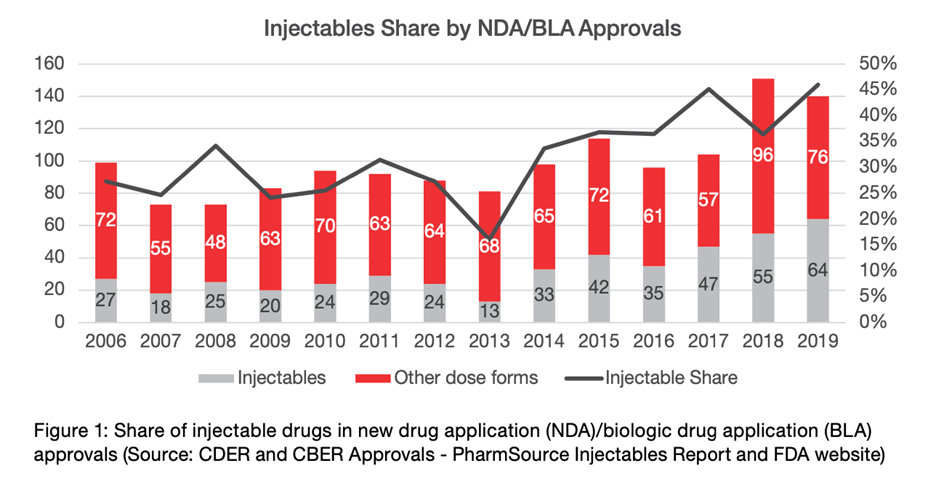Moving from vials to prefilled syringes for vaccines: Three key success factors
Category | Steriles
As pharmaceutical companies become more patient-centric and self-administration of injectable drugs continues to increase, the market for drug products in prefilled syringes is forecast to grow, reaching $9.53 billion by 2026.1 This growth is driven primarily by the growth of biologics (Figure 1).
Prefilled syringes are popular with clinicians and patients alike due to patient safety and reduced potential for contamination.
Patient benefits of prefilled syringes include:2
- Ability for rapid administration
- Self-administration of chronic disease treatments at home rather than in a hospital
- Lowered risk of microbial and chemical cross-contamination
- Improved dosing accuracy
From the pharmaceutical company’s perspective, switching from vials to prefilled syringes can reduce manufacturing costs due to decreased wastage of active pharmaceutical ingredient (API). Only trace amounts remain in the needle after injection, increasing the overall yield.
Key considerations for vaccines
There are many factors to consider for vaccines in prefilled syringes. These include equipment capacity and flexibility; expertise in managing prefilled syringes based on dosage regimen; and track record in overcoming hurdles during development. Unique success factors center on storage, supply chain, and regulatory requirements.
Vaccines, which contain temperature-sensitive substances, require storage temperatures as low as –40°C. Syringes comprise more complex combinations of materials than vials; development must demonstrate their suitability for such extremely cold storage conditions. To develop an optimal process, sponsors should consider working with partners with proven expertise in both materials and fill and finish, encompassing:
- Formulation development
- Screening of syringes and plungers
- Assessment of compatibility of containers with vaccines
- Holding time studies
- Freeze and thaw studies
- Container closure integrity during a temperature excursion
- Gliding and break-loose force temperature dependence
- Shipping studies
- Scalability studies
Patient benefits of prefilled syringes
Benefits of prefilled syringes include:2
- Ability for rapid administration
- Self-administration of chronic disease treatments at home rather than in a hospital
- Lowered risk of microbial and chemical cross-contamination
- Improved dosing accuracy
For process development and optimization, it is helpful to have a single partner that can provide a streamlined transfer from initial development phases through to commercial scale. This enables potential hurdles to large-scale transfer to be addressed from the outset.
For successful manufacture and distribution of vaccines, all necessary raw materials and qualified transportation options need to be planned for and prepared. This can be accomplished through a turnkey service embracing all steps from manufacturing to distribution. Strategic sourcing for primary packaging components is a key success factor. The selection of components from the preliminary phase can yield a competitive advantage for a vaccine in a prefilled syringe. It is essential to establish a close relationship with container and/or autoinjector suppliers to secure stocks and, when possible, build a flexible manufacturing platform enabling easy changing of parts when multiple filling volumes or diverse formats are requested.
For distribution, success can be ensured by using:
- Temperature sensors in every shipment to track any temperature excursions, even when employing new shipment options.
- Advanced monitoring platforms to allow remote and visual monitoring of package location from a computer dashboard. This technology can be paired with temperature sensors.
- Digitalization and connectivity between the network of suppliers, vendors, and collaborators to allow seamless transactions facilitated by instant notifications, virtual audits, orders, and automated updates.
For steriles, and for syringes in particular, the regulatory landscape is very challenging. Planning is important from the earliest stage of development to determine the best time to switch from vials to prefilled syringes. This change involves demonstrating the robustness of the vaccine formulation in various containers, and the suitability of the primary packaging components for all approved storage conditions. Recent, up-to-date experience in dealing with local and global regulatory bodies plays a crucial role in the development of a global plan for a vaccine in a prefilled syringe. A typical path is based on a risk/benefit approach. A clear definition of the final target product profile can enable appropriate planning of studies required to make the switch between containers flawless—and avoid unwelcome surprises later in development.
In conclusion, a move from vials to prefilled syringes can lead to many benefits for stakeholders, including patients, health care providers, and drug manufacturers. The three key success factors discussed earlier can ensure that all challenges are addressed as this transition is managed. Together, these provide a complete understanding of the critical parameters that can affect the overall stability of the final presentation in a prefilled syringe—avoiding waste of valuable resources and enabling selection of the best primary packaging for successful commercialization.3



